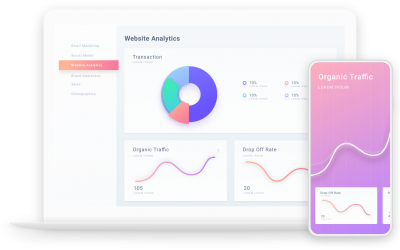Introduction
Your website is like a digital welcome mat, but what if visitors just glance at it and then bounce away? That’s where the “bounce rate” comes in – it’s the percentage of visitors who leave your site after viewing only one page. A high bounce rate can be alarming, but don’t worry! In this guide, we’ll unravel the mysteries of bounce rates and provide you with simple strategies to keep visitors engaged and clicking.
Section 1: Understanding Bounce Rates
What Is Bounce Rate?
Before we dive into the fixes, let’s define “bounce rate.” It’s the percentage of visitors who land on your website and leave without clicking on any other pages or interacting further. A high bounce rate may indicate that your website isn’t engaging enough or doesn’t fulfill visitor expectations.
Why Bounce Rate Matters
A high bounce rate isn’t just a vanity metric – it can affect your website’s performance. Search engines like Google use bounce rates as a signal of user satisfaction. A lower bounce rate can improve your site’s search engine rankings, making it more visible to potential visitors.
Section 2: Enhancing Your Website’s Appeal
User-Friendly Design
A clean, organized, and visually appealing website encourages visitors to explore further. Make sure your navigation is intuitive and your content is well-structured.
Page Load Speed
Slow-loading pages can drive visitors away. Optimize your website’s speed by compressing images and minimizing unnecessary scripts.
Section 3: Content Matters
High-Quality Content
Create informative, relevant, and engaging content that addresses your audience’s needs. When visitors find valuable information, they’re more likely to stick around.
Clear Headlines and Subheadings
Use clear and concise headlines and subheadings to guide visitors through your content. Break up text into easily digestible sections.
Multimedia Elements
Incorporate images, videos, and infographics to make your content more engaging. Visuals can capture attention and encourage further exploration.
Section 4: Mobile-Friendly Design
Responsive Design
Ensure that your website is mobile-friendly. With an increasing number of users accessing websites on mobile devices, a responsive design is essential.
Section 5: The Power of Call-to-Actions (CTAs)
Compelling CTAs
Include persuasive CTAs that encourage visitors to take the next step. Use action-oriented language like “Get Started” or “Learn More.”
Strategic Placement
Place CTAs strategically throughout your website, making them easily accessible without overwhelming the visitor.
Section 6: Navigation Simplicity
Intuitive Navigation
Make it easy for visitors to find what they’re looking for. A clear and intuitive menu structure is essential for reducing bounce rates.
Search Functionality
Implement a search bar to help users quickly locate specific information or products.
Section 7: Load Time Optimization
Minimize Popups
While popups can be effective, excessive or intrusive ones can drive visitors away. Use them sparingly and ensure they are easily dismissible.
Optimize for Mobile
Ensure your website is responsive and loads quickly on mobile devices. Mobile users are less patient with slow-loading sites.
Section 8: Monitoring and Analysis
Use Analytics Tools
Leverage tools like Google Analytics to track user behavior on your website. Identify which pages have high bounce rates and require attention.
Set Benchmarks
Understand what constitutes a good bounce rate for your industry. Benchmark your performance against similar websites to set realistic goals.
A/B Testing
Experiment with variations of your web pages to see what resonates best with your audience. A/B testing can reveal valuable insights.
Section 9: Engaging Content Strategy
Fresh Content
Regularly update your website with fresh content, such as blog posts or news updates. An active website can keep visitors coming back.
Internal Linking
Link to related pages within your content to encourage visitors to explore further. Relevant internal links can reduce bounce rates.
Conclusion
A high bounce rate may seem daunting, but with the right strategies, you can turn things around. By focusing on user-friendly design, engaging content, mobile optimization, clear CTAs, and thoughtful navigation, you can reduce bounce rates and keep visitors on your website longer. Remember, it’s an ongoing process, so continuously monitor your performance, experiment, and refine your approach. Soon, you’ll see improvements in engagement and a more satisfied online audience.






